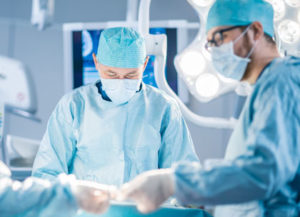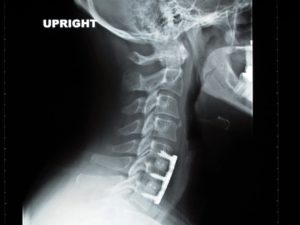Anterior Cervical Discectomy and Fusion Surgery
Anterior Cervical Discectomy (ACDF) Explained
A discectomy is a procedure that removes a damaged, arthritic, or herniated intervertebral disc (the “cushion” between adjacent bones of the spine). An anterior surgical approach means an approach from the front of the body, and the cervical spine is the spine in the neck. So an anterior cervical discectomy is a procedure that removes a damaged intervertebral disc from the spine in the neck, using a surgical approach from the front of the neck.
Cervical Fusion for Spinal Stability
An anterior cervical discectomy is often performed along with procedures called fusion and fixation to ensure spinal stability. A fusion is the implantation of a bone graft that will fuse (and grow together) with vertebrae (bones of the spine) in the area. A fixation is the implantation of screws, rods or plates. A fixation is a common way to hold the bones in place while they fuse. An Anterior Cervical Discectomy and Fusion is often abbreviated ACDF.
We’re affiliated with Piedmont Hospital

Conditions Treated with ACDF:
- Neck Pain
- Arm Pain, Tingling & Numbness

Why is ACDF surgery done?
Anterior cervical discectomy is performed for patients who have experienced changes such as degeneration and bone spurs (growth of bony projections) in the discs of the cervical spine, and for those with herniated discs.
These conditions can affect the amount of space available for the spinal cord and nerves. As a result, the spinal cord and nerves can become compressed (pinched), and even injured.
Before surgery is considered, Dr. Rezaiamiri may recommend nonoperative measures such as pain medications and physical therapy.
Surgery is typically the recommended treatment when the spinal cord is at risk of damage. Surgery may also be warranted for those patients who do not find relief with nonoperative treatment.
ACDF Procedure
The process of the procedure starts with filling out paper work, and discussing any medications with our doctors. You’ll also have some pre-surgical tests such as blood tests, electrocardiogram, and possibly a chest X-ray, which might need to be done days before the surgery. If certain medications need to be stopped, you’ll have to consult with a primary care physician about that to make sure you’re cleared for surgery. Ceasing any NSAIDs (ibuprofen, Advil, etc.) and blood thinners 7 days before surgery is another step. Avoiding smoking, nicotine and alcohol before surgery is also recommended to avoid bleeding and healing issues.
The day of the surgery you will want to avoid eating or drinking after midnight the previous night, unless noted otherwise. A shower with antibacterial soap is recommended, with clean loose fitting clothing and flat shoes. Lists of medications and allergies are useful to bring as well.
 During ACDF Surgery
During ACDF Surgery
The operation proceeds through a standard process that starts with anesthesia, which is followed by the neck area being cleaned and prepped. If your own bone is used for the fusion process the hip is also prepped to retrieve a bone graft. The operating surgeon makes a 2 inch incision on the right or left side of the neck and moves aside muscles and retracting the trachea to reach the spinal area.
Once the damaged disc is located, the outer wall is cut and the disc is removed using small grasping tools. Any bone spurs that put pressure on nerves are also removed, and the foramen is enlarged if needed. The bone graft is placed where the damaged disc previously was located, and usually reinforced with a metal plate that’s screwed in place to stabilize the spine during the fusion process. Finally, the surgical tools are removed and skin sutured together, with strips or biologic glue placed across the incision site.
Anterior Cervical Discectomy and Fusion Risks
An anterior cervical discectomy, like any surgical procedure, is associated with a certain amount of risk. However, this risk is usually small. Recommendations vary by case, and a neurosurgeon will be able to explain the risks and benefits of the procedure for any individual case.

How long does anterior cervical discectomy and fusion take & where is it performed?
An ACDF operation typically takes about one to two hours to perform depending on the number of disc levels. It is performed in one of our surgery centers in Stockbridge or Decatur or it may be necessary to have it performed at the hospital.
Anterior Cervical Discectomy and Fusion Surgery Recovery Time?
Typically 3 weeks is enough time to get back to light work around the house, such as lifting up to 10 pounds. However, ACDF surgery recovery time varies from patient to patient. The quickest recovery can be people returning to work within days or a week after surgery. Other patients may start physical therapy a few weeks after the surgery takes place, and continue for 2-3 months.
 ACDF Post Op Care
ACDF Post Op Care
After the surgery the main concerns are relieving pain and inflammation at the surgery site. Using various pain treatments such as cold packs, massage, and other techniques can help in the recovery. Exercising the muscles that stabilize the back is also important, and learning how to go through physically demanding activities safely without harming your back is important.
For a couple weeks after surgery you should avoid bending or twisting the neck, and avoid lifting anything heavier than 5 pounds. Our doctors will go over ACDF post operative protocols with you in detail, but generally any strenuous activity should be on hold during the early recovery period. Smoking or use of nicotine products should also be avoided since it inhibits bone growth, as well as alcohol.
Anterior Cervical Discectomy and Fusion Success Rate
The ACDF success rate is relatively high as a pain management treatment. Between 70 and 80 percent of people who received an ACDF operation for neck pain reported relief from pain. ACDF can be incredibly helpful to people living with neck pain every day, particularly if the pain is out of control or causes numbness. You’ll be able to return to activities you may have stopped because of neck pain or lack of neck or arm movement.


